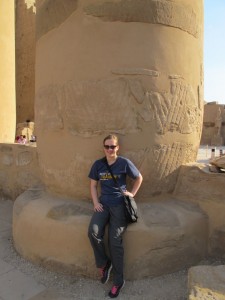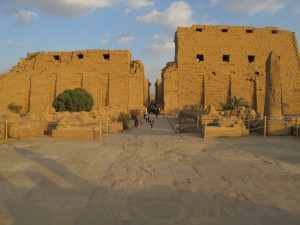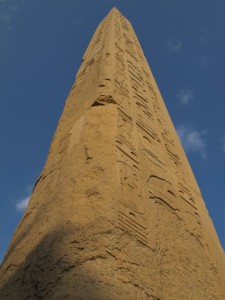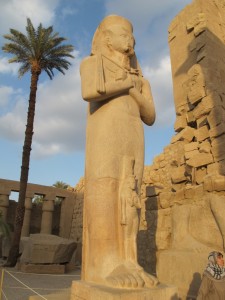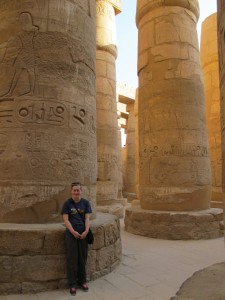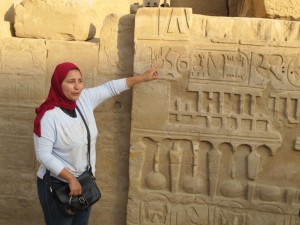Egypt is a land of iconic sights. The pyramids and sphinx are probably best known due to their ancient wonder pedigrees. But for my money, Karnak Temple in Luxor should be right up there with the big guns. Knowing we had many temples to visit in our future, perhaps it was an injustice for us to take our intrepid group to see Karnak first. Truly, this is the mother of all Egyptian temple complexes. It is the largest in Egypt and the second largest in the world after Angkor Wat in Cambodia.
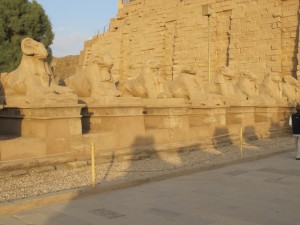
The complex, covering more than a square mile, boasts an amazing collection of temples, sanctuaries, obelisks, columned halls, statues, and pylon gates. An avenue lined with ram-headed sphinxes stretches from Luxor Temple (a festival temple) in the center of town to the southern entrance pylon.
Karnak was the primary center of worship for the New Kingdom and was used daily by royals and commoners alike. After the omnipresent security check we entered the site with our Egyptologist guide Hoda. A secondary avenue of sphinxes leads from the Nile to the primary entrance gate.
This towering pylon stretches 100 feet high and 300 feet across. The scale alone projects the power, authority, and majesty of the pharaohs of old. Inside the complex opens up to a series of courtyards and sanctuaries. Two of the original four obelisks rise from a central courtyard. These monolithic granite towers stand witness to the ancients’ engineering and building prowess. Even with modern equipment it would be hard to imagine cutting, shaping, transporting, and erecting these huge monuments to kingly grandeur. Hoda informed us that the obelisks have no mortar or other securing devices and merely rest on flat bases. A couple of immense statues of pharaohs and the huge relief sculptures of various elements of Egyptian mythology carved into the 8 pylons also add to the mystical projection of pharonic power.
But honestly, everything I’ve described to this point is mere preamble to the spectacular Great Hypostyle Hall. Audible gasps and proclamations of “wow” were heard as our group entered the hall. This is the Egypt of our travel imaginations! The 134 gigantic columns cover an area of 6000 square feet. Each of the papyrus-styled behemoths is a staggering 33+ feet in circumference. 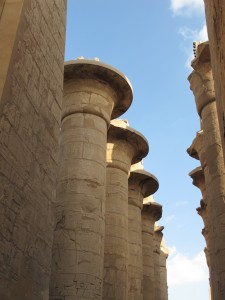 Maia described the feeling beautifully as like wandering into a grove of giant sequoias. But these mighty redwoods are man-made and carved with the stories of gods, goddesses, pharaohs, priests, and conquests. There is but one way to describe the feeling one has when standing among this forest of pillars: insignificant. One easily understands the message of such daunting architecture. You are in the presence of the gods, and their unchallengeable representative, the king. Even in our modern age of engineering wonders these jaw-dropping ancient stones are nothing less than phenomenal. I shot dozens of photos, trying to find the angle that allows an image to portray the sense of being here. But alas, photographs serve merely and only to remind one of the actual experience. But that’s why we travel after all.
Maia described the feeling beautifully as like wandering into a grove of giant sequoias. But these mighty redwoods are man-made and carved with the stories of gods, goddesses, pharaohs, priests, and conquests. There is but one way to describe the feeling one has when standing among this forest of pillars: insignificant. One easily understands the message of such daunting architecture. You are in the presence of the gods, and their unchallengeable representative, the king. Even in our modern age of engineering wonders these jaw-dropping ancient stones are nothing less than phenomenal. I shot dozens of photos, trying to find the angle that allows an image to portray the sense of being here. But alas, photographs serve merely and only to remind one of the actual experience. But that’s why we travel after all.